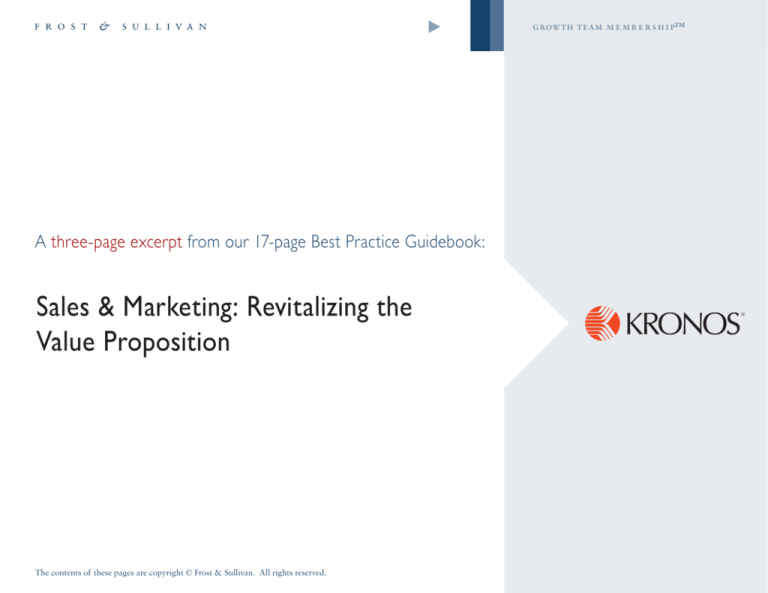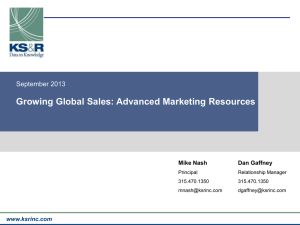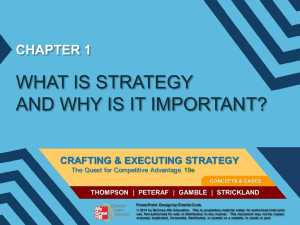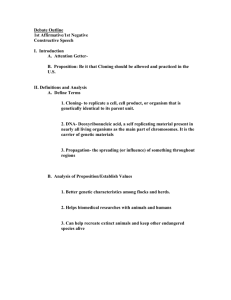
growth team m e m b e r s h i p™
A three-page excerpt from our 17-page Best Practice Guidebook:
Sales & Marketing: Revitalizing the
Value Proposition
The contents of these pages are copyright © Frost & Sullivan. All rights reserved.
growth team m e m b e r s h i p™
Best Practice Guidebook
Sales & Marketing: Revitalizing the Value Proposition
guidebook summary
Firm: Kronos
Industry: Software Services and Applications
Headquarters: Chelmsford, Massachusetts, United States
Geographic Footprint: Global
Ownership: Private
Revenue (2012): $870 million USD
Problem:
Slowing product growth forces Kronos’ marketing and sales organizations
to create and deliver a differentiated value proposition.
Solution:
Sales and Marketing collaborate to:
• Evaluate the existing value proposition
• Create a revised value proposition and promote it companywide
through a Foundational Messaging Guide
• Translate the value proposition into compelling sales messages
• Encourage adoption of new messages and delivery techniques by the
sales force
Business Results:
• Since 2008, Earnings Before Interest, Taxation, and Amortization
(EBITA) increased 36%
• 92% of Kronos’ sales force consistently use the new customer
messages
The contents of these pages are copyright © Frost & Sullivan. All rights reserved.
Resources Required:
• Marketing leadership (CMO and direct reports) to lead the initiative
and engage sales leadership
• A branding and messaging agency to run focus groups
• A consulting firm to train the sales force to deliver differentiated
customer messages
Applicability of Best Practice to Executive Functions:
Function
Marketing
Sales Leadership
Applicability
1
growth team m e m b e r s h i p™
best practice guidebook
2
Kronos’ marketing leadership works with Sales to revitalize
the value proposition and create differentiated sales messages
Creating and Embedding a New Value Proposition
Revisit Existing Value
Proposition
Create New Value
Proposition
Develop Sales
Messages
Drive Sales Force
Adoption
Objective
Conduct a baseline assessment
of the current value proposition’s
strengths and weaknesses
Objective
Develop differentiated value
proposition
Objective
Translate the value proposition into
sales force messaging
Objective
Achieve 100% adoption of new
messaging by sales force
Activities
•Perform market assessment
•Conduct brand positioning
workshop
•Run customer/prospect focus
groups
Activities
•Conduct Affinity Diagramming
exercise to identify customers’
Critical Business Issues (CBIs)
•Pinpoint how Kronos
uniquely addresses these CBIs
and translate into a value
proposition
Activities
•Conduct Power Messaging®
Workshop with sales and
marketing leadership to update
messaging and techniques
Activities
•Conduct Power Messaging®
Workshops with entire sales
force
•Establish Sales and Marketing
Leadership Councils by vertical
market
Output
•Market assessment
•Focus group findings
•Governing Brand Idea (GBI)
Output
•Critical Business Issues (CBIs)
and key differentiators
•New value proposition
•Foundational Message Guide
(FMG)
Output
•New messaging techniques
•Portfolio of customizable
messages
Output
•Sales force adoption of
customizable messages and
techniques
•Industry-specific Sales and
Marketing Leadership Councils
to drive ongoing adoption
The contents of these pages are copyright © Frost & Sullivan. All rights reserved.
Source: Kronos; Growth Team Membership™ research.
growth team m e m b e r s h i p™
best practice guidebook
3
key takeaway: Pressure-test your market understanding and value proposition
Marketing commissions a market assessment to gain
perspective on the category and Kronos’ position within it…
…and then conducts a workshop
to craft new brand positioning
Market Assessment
Brand Positioning Workshop
Participants
Senior sales and marketing executives participate in a one-day
workshop
Objectives
• Audit existing marketing messages and collateral to
determine extent of competing messages and identify steps
to rectify
• Develop preliminary Governing Brand Ideas (GBI) to
be tested in focus groups. The GBI will serve as the
overarching brand positioning for a new value proposition.
Situation
Kronos management believed the firm was the market
leader, but product revenue growth was flat despite
category growth. Therefore, Kronos commissioned a
third-party assessment of the workforce management
market.
Objective
Capture the current state of the workforce management
category by analyzing:
• Market size
• Competitive landscape
• Customer segments
• Kronos brand awareness and brand associations
• Purchase consideration factors for Kronos
Findings
33Two customer segments exist:
-- Ease-of-use buyers who value straightforward
implementation with low cost of ownership (50%)
-- Functionality users that value advanced
features (50%)
Kronos is the market leader, but growing slower than
the market
Kronos lacks a compelling category positioning:
-- Lower than expected awareness and
consideration rates
-- Fractured and diluted brand messaging
The contents of these pages are copyright © Frost & Sullivan. All rights reserved.
The workshop employs three criteria for the GBI:
1.It conveys Kronos’ understanding of the workforce
management category
2.It is simple and direct
3.It reflects Kronos’ ability to help—doesn’t over-promise
Preliminary Governing Brand Ideas (GBI)
Need to revise brand
positioning to appeal
to both segments
“The experience to
know it’s complex. The
expertise to simplify it.”
“Workforce
management doesn’t
have to be so hard.”
“Simple solutions that
work hard.”
Source: Kronos; Growth Team Membership™ research.
growth team m e m b e r s h i p™
Please contact us to learn how to access the full Best Practice
Guidebook or for information on Growth Team Membership.™
Email us GTMresearch@frost.com
Visit us online www.gtm.frost.com
The contents of these pages are copyright © Frost & Sullivan. All rights reserved.









